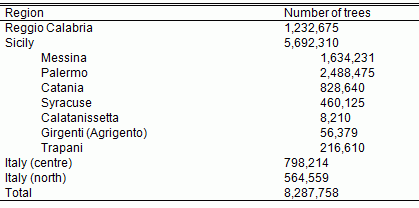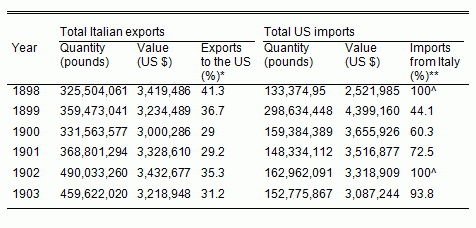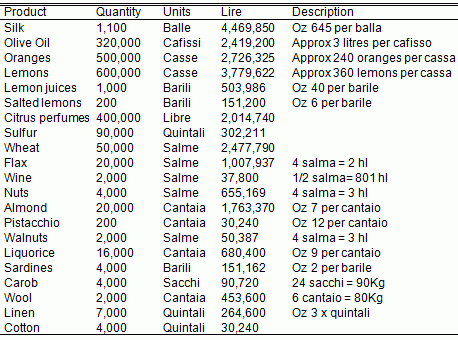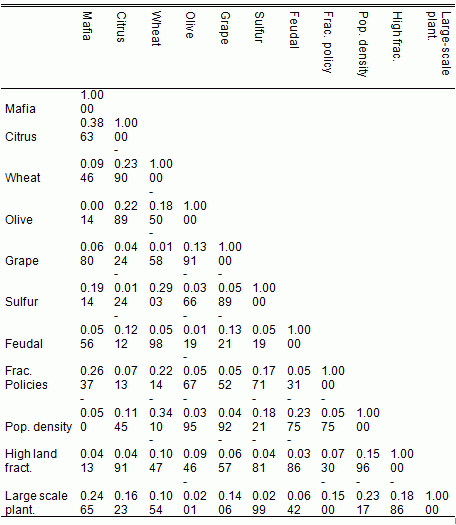The Italian Mafia can be seen as one of the largest and most successful businesses in Italy. In one of the latest reports from the Italian Minister of Home Affairs, it has been estimated that revenues from just the informal sector related to the Mafia amount to almost €180 billion. In terms of GDP, revenues from Mafia-related businesses represent almost 12% of the total Italian GDP and are equal to the sum of the GDPs of Estonia, Croatia, Romania, and Slovenia (Ruffolo et al. 2010). To date, the Italian Mafia is the most successful form of organised crime in Europe and comparable to the Chinese, Japanese, Russian, and South American crime organisations in terms of business.
Given the economic and social relevance of the issue, it is natural to wonder why these forms of organised crime develop and what factors explain the cross-regional variation of Mafia. Both institutional and historical explanations have been proposed in the literature. Fiorentini (1999), Grossman (1995), and Skaperdas (2001) focus on weak institutions, predation, and enforcement of property rights. On the other hand, with regard to the Sicilian Mafia, Villari (1875), Sonnino and Franchetti (1877) and Colajani (1885) focus on the legacy of feudalism, the development of latifundism and a loss of social capital and public trust.
Even though the above literature provides plausible explanations for the origin of organised crime, it is still difficult to understand why we observe a huge variation across regions experiencing very similar conditions. Organised forms of crime normally appear only in a small number of localities and then expand through the entire region. It is therefore important to understand what is specific to these few localities where the Mafia appears.
In a new paper (Dimico et al. 2012), we try to explain such a variation of the Mafia across villages in Sicily using a parliamentary inquiry about the economic, social and moral conditions of Sicilian peasants in 1886. Our hypothesis is that the regional variation in the presence of the Mafia depends on the development of the lemon industry in Sicily. We argue that Sicily had a dominant position in the international lemon market which was the result of barriers to entry related to the particular climatic requirements for lemon trees to vegetate. These particular climatic conditions required by the plant provided variation across countries and across villages that could produce lemons, resulting in a natural dominant position for countries on the Mediterranean, particularly for Sicily. The dominant position, together with a boost in the international demand after the 19th century (when Lind proved the beneficial effect of lemons in curing scurvy), provided huge profits associated with the sector which the Mafia systematically used to extort in exchange for protection which could not be provided by the state. We view such profits from imperfect market structures as a natural condition for the development of the Mafia.
Table 1 reports the distribution of lemon trees in the south of Italy in 1898. The total number of trees in Sicily amounts to almost 70% of all trees in Italy, affording Sicily a national dominant position in the industry.
Table 1. Distribution of lemon trees in Southern Italy in 1898
Source: Powell (1909)
Table 2 shows the international position of Italy (and therefore of Sicily) in the international lemon market. A large share of the Italian production of lemons is exported to the US, and the largest share of lemons imported into the US comes from Italy. Besides the US, France and the UK also used to import a large share of citrate from Italy and, according to Powell (1908), the quantity imported by these two countries was at least as large as the US one. If we consider the US, the UK, and France as the three largest markets in the 19th century then it is clear that Italy (and Sicily mainly) had a dominant position in the international lemon market.
Table 2. Total Italian exports of lemons and total US imports
Notes: *Percentages provided by Powell (1909). ** Percentages estimated using percentages on quantity exported from Italy above. For example for the year 1900 the quantity exported to the US is 331,563,577*0.29=96,153,473 which divided by 159,384,389 provides a percentage equal to 60.32 percent. ^ In 1898 and 1902 the percentage exported from Italy to the US exceeds the total import into the US. This is because Italian figures refer to the calendar year, while USA figures refer to the fiscal year.
Source: Powell (1909)
Given the extent of the production and the international demand for lemons, the sector was of strategic importance for the local Sicilian economy. This is shown in Table 3, where we report descriptive statistics for the most important goods exported, quantity, and revenues from the harbour of Messina in 1850. Revenues from citrus and derived products are almost equal to 9.2 million lire, accounting for almost 42.4% of the total export revenues. Given the large profits associated with the sector, the Mafia could extort part of these profits in exchange for providing protection.
Table 3. Exports from the Harbour of Messina in 1850
Source: Battaglia (2003)
Data and empirical analysis
We collect data at the town level for the entire island from the Damiani Inquiry (1886). This investigation was part of a larger inquiry, approved in March 1877 and proposed by Stefano Jacini, that aimed to assess the conditions of the agricultural sector and the conditions of peasantry in every region of Italy. The Damiani Inquiry represents one of the earliest and most important primary sources on the economic and social conditions of Sicily in the 1880s and provides valuable information about the kind of crops produced, tax burden, wages, relations between peasants and landlord, lewdness and religiousness of people, corruption of the clergy, rule of law, and crime. Using this source, we code variables for the presence of the Mafia, kind of crops produced, scale of the plantation, rule of law and other important variables and find that the presence of the Mafia is strongly associated with production of lemons. Table 4 reports the pairwise correlation, which shows the Mafia is positively correlated with citrus (0.39 correlation), with large-scale plantations (0.25 correlation), and with the effectiveness of the fractionalisation policy (0.26 correlation), as argued by Bandiera (2003). We also perform a more detailed regression analysis, using Probit, OLS, and IV estimators and the relation between Mafia and production of lemons is largely confirmed.
Table 4. Pairwise correlations
Conclusion
Unlike existing works that emphasise institutional and historical factors, this study analyses the importance of the presence of fixed costs as a source of market imperfections and very high profits in certain towns. We argue that the production of oranges and lemons was associated with a strong international demand as well as substantial fixed costs during the late 1800s. This profitability, combined with a general vacuum of institutions, provided an ideal breeding ground for a mafia providing private protection to lemon producers.
References
Bandiera, O (2003), “Land Reform, the Market for Protection, and the Origins of the Sicilian Mafia: Theory and Evidence”, Journal of Law, Economics, and Organization, 19(1): 218-244.
Battaglia, R (2003), “L’ultimo Splendore: Messina tra Rilancio e Decadenza. Rubbettino Editore Colajanni, Napoleone, 1885”, La Delinquenza della Sicilia e le sue Cause. Giornale di Sicilia.
Damiani, A (1886), Atti della Giunta per l.Inchiesta Agraria e sulle Condizioni della classe Agricola, Forzani Tip. Del Senato tomo 2 fasc 4 (Archivio Centrale Roma)
Dimico, A, A Isopi and O Olsson (2012), “Origins of Mafia: The Market for Lemons”, Scandinavian Working Paper in Economics No 532.
Fiorentini, G (1999), “Organized Crime and Illegal Marteks”, Dipartimento di Scienze Politiche, Universita di Bologna WP 8400
Grossman, H I (1995), “Rival Kleptocracies: The Mafia versus the State”, in Gianluca Fiorentini and Sam Peltzman (eds.), The Economics of Organized Crime, Cambridge University Press.
Powell, H G (1909), “Italian Lemons and Their By-Products”, Bulletin No. 160, Bureau of Plant Industry, US Department of Agriculture.
Ruffolo, G, E Veltri, F Archibugi, and A Masneri (2010), Rapporto sulla criminalita in Italia. Analisi, Prevenzione, Contrasto. Ministero degli Interni con Stime Aggiornate dal Centro Studi di Confindustria per Ottobre 2010, Ministero Degli Interni
Skaperdas, S (2001), “The Political Economy of Organized Crime: Providing Protection When the State Does Not”, Economic of Governance, 2:173-202.
Sonnino, S and L Franchetti (1877), La Sicilia nel 1876. Firenze, Tip. di G. Barbera Villari, Pasquale, 1875. Lettere Meridionali. L.Opinione








